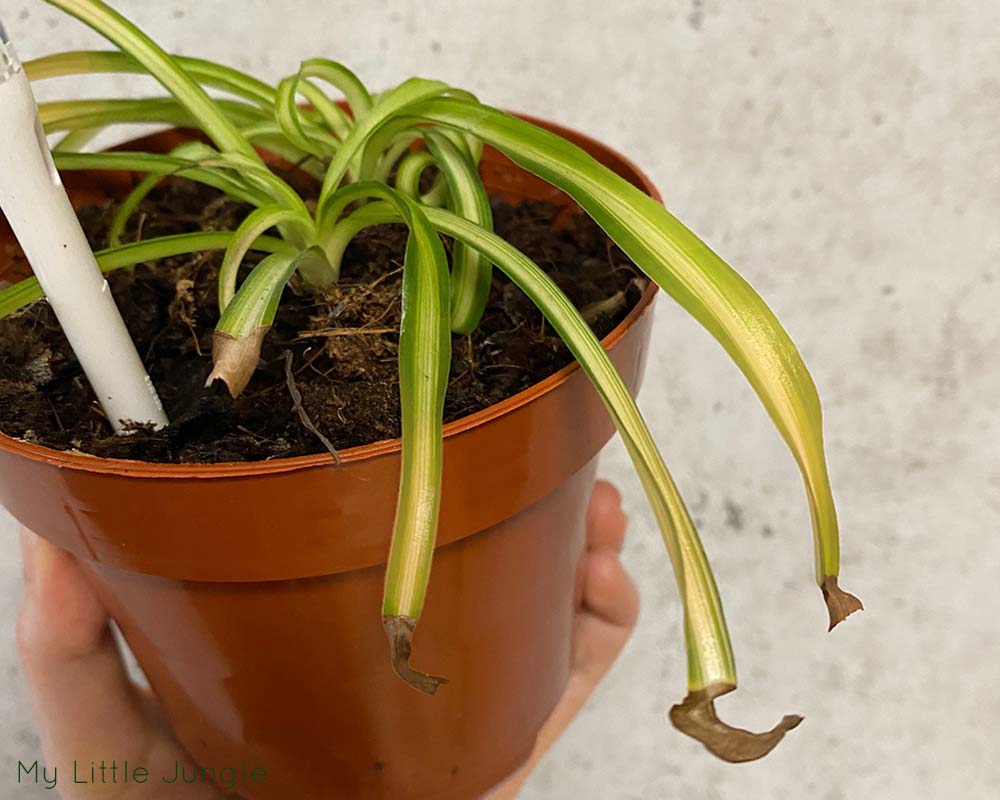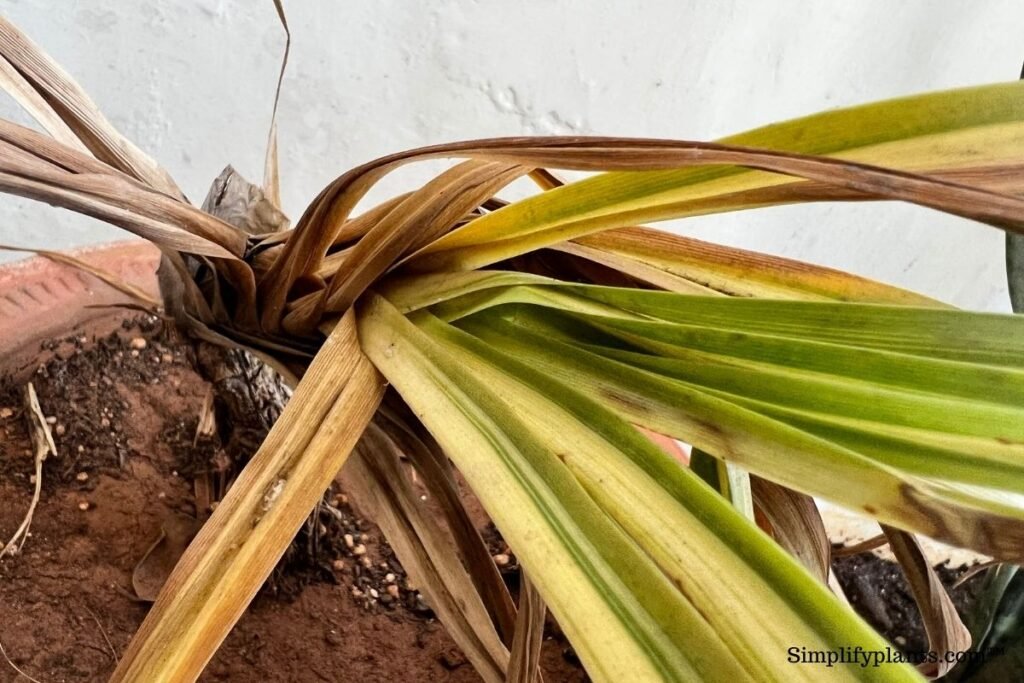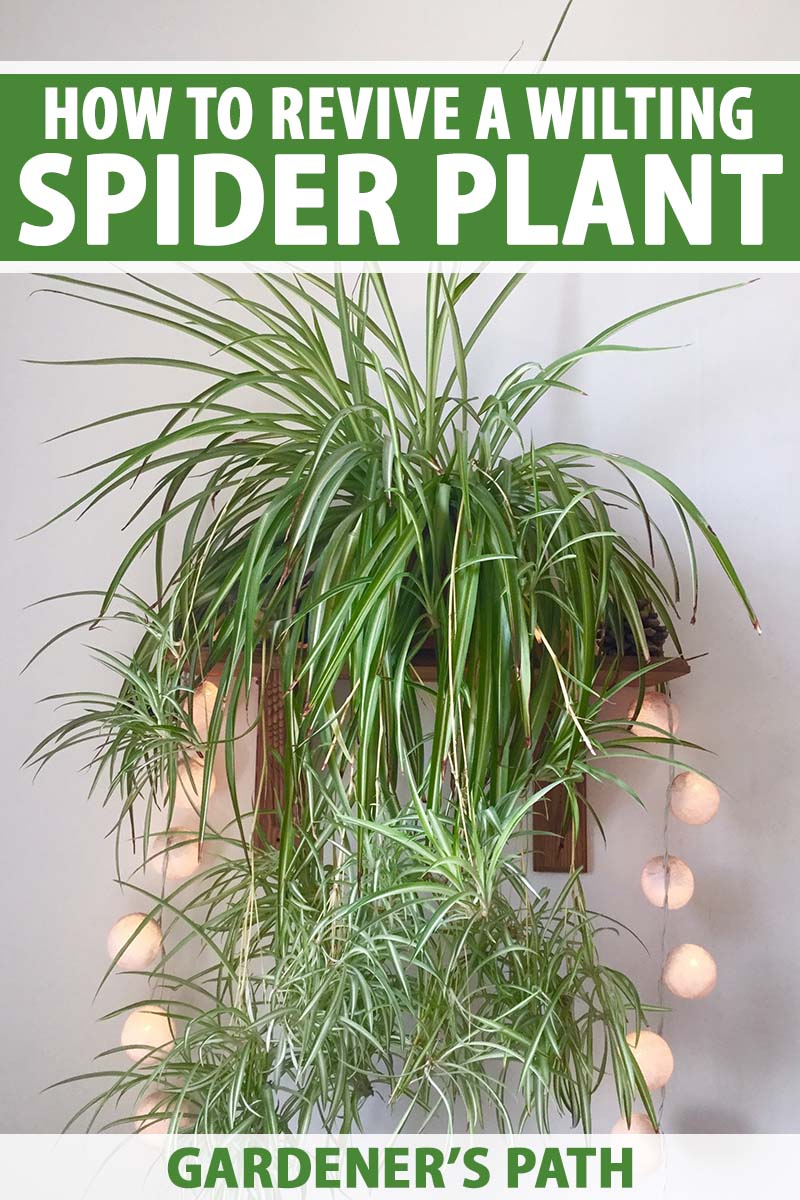The most common cause of dying spider plants is root rot brought on by over watering, which makes the plant droop and appear dead. Overfertilization, inadequate hydration, and low humidity can all cause spider plants to wither away, leaving behind brown leaf tips.
It’s crucial to properly hydrate a dying spider plant, letting the top 2 inches of soil dry out between waterings, maintaining the ideal temperature for growth, placing the spider plant in bright indirect light, and simulating some aspects of its natural environment.
Read on to discover the cause of your spider plant’s demise and how to fix it.
Table of Contents
Spider Plant Leaves with Brown Tips
- Symptoms: Spider plant leaves frequently becoming brown, with dry-looking brown tips at the ends of the leaves.
- Causes include extremely low humidity, inadequate or excessive watering, draughts or air conditioning, too much fertilizer, sunburn, freezing weather, and water fluoridation.
Spider plants are indigenous to South Africa, where they flourish in a warm, humid climate with regular rainfall.
When caring for spider plants, if you don’t reproduce these circumstances, the leaf tips may turn dark and appear to be dying overall.
Drought Stress Causing Spider Plants Brown Leaf Tips
When spider plants are under drought stress from inadequate watering, low humidity, or air currents that rob moisture from the leaves faster than the roots can absorb it, the tips of the leaves most frequently turn brown.
Spider plants have evolved to withstand some drought because they store water in their fleshy, deep roots and rhizomes, but if the soil is completely dry, they will get brown tips.
The low humidity in your houses is in contrast to the tropical regions of Africa where spider plants are native, and it can also create stress by increasing the pace at which water is lost from the leaves, leading to brown leaf tips from dehydration.
Brown leaf tips can also result from water loss from the leaves being exacerbated by air currents in our homes from air conditioning, forced air, draughts, or conventional currents from sources of heat.
How to Revive Spider Plants with Brown Leaves due to Drought Stress
If drought stress is the root of the spider plant’s brown leaf tips, the plant should begin to recover after a few watering cycles in the coming weeks.
If the drought stress was severe, it is frequently required to clip the brown ends of the leaves because they rarely turn green or variegated again.
To encourage further development and enhance the plant’s overall appearance, just prune the ends of the leaves with a pair of sterile pruners.
(Read my post on essential advice for watering spider plants for more details.)
Brown Leaf Tips due to Fluoride in Tap Water
Spider plants are extremely susceptible to fluoride and chlorine in drinking water. In response to exposure to fluoride, the tips of the leaves may become brown and even begin to die back.
In order to prevent the buildup of dangerous chemicals, it is therefore best practice to hydrate your spider plants with filtered water or rainwater rather than tap water.
To make your spider plant seem better, simply remove the brown leaf tips with a sterile pair of pruners due to fluoride or chemical sensitivity, and refrain from watering it with tap water.
In the spring and summer, spider plants grow fairly quickly and should fully recover.
Excess Fertilizer Causes Spider Plant leaf Tips to to Brown
Although they may not be frequent feeders, spider plants do benefit from feeding in the spring and summer.
The leaf tips get brown and crispy as a symptom of stress if fertilizer is applied too frequently, in excessive concentrations, or during the Winter when the plant is growing slowly (and hence has a lesser demand for nutrients).
From Spring to the middle of Summer, spider plants normally need a half strength application of balanced, general house plant fertilizer once a month to be healthy.
A buildup of salts in the soil brought on by excessive fertilization makes it challenging for roots to absorb moisture.
Take the spider plant out of its pot and throw away the surrounding dirt to revitalize spider plants that have brown leaf tips from too much fertilizer.
Repot the spider plant and add fresh potting soil to the area where the dirt was previously (it had accumulated too much salt).
After replanting, give the plant a good bath to help reduce transplant shock and dissolve any extra salts that may still be present around the roots.
If the leaf tips do not appear to have recovered, prune them back with sterile pruners to encourage new development.
Temperatures Higher then 80°F and Lower then 55°F causes Spider Plant Leaf Tips to Turn Brown
For spider plants, the ideal growing conditions are warmer than 55°F (12°C) at night and between 65°F (18°C) and 75°F (23°C) during the day.
The spider plant’s leaves will become stressed and turn brown or occasionally black if the temperature is consistently higher than 80°F (27°C) or much lower than 55°F for an extended period of time.
The best temperature range for growing spider plants is around room temperature, and they prefer bright indirect light over direct sunlight.
If your spider plant is in the sun, move it to a spot with more shade.
Because spider plants are tropical, they can develop brown tips when their leaves come into contact with a cold window, which may even be frosty in the winter. If you live in a cold region, make sure the leaves are not in contact with windows.
The plant should recover if you remove any brown and damaged leaf tips to encourage new development.
(Read my essay on the spider plant’s slow growth and lack of offspring.)
Leaves Turning Brown due to too Much Sun
Spider plants are adapted to growing in shade under a tree canopy and may withstand some dappled light, but they thrive in direct, bright sunshine.
If the leaves are exposed to direct sunlight, the plant may dry up and develop brown leaf tips or it may experience sunburn, which will cause the majority of the leaf to turn brown where it is exposed to the sun.
A spider plant can die from too much sun exposure, so you should shift it to shade as soon as you can.
It is possible that the direct sun has created some drought stress, but you may assist the spider plant recover with some watering and by misting the leaves.
It is crucial to clip these individual leaves at the plant’s base to improve the appearance because sun-burned leaves do not turn green again.
Only remove a few leaves at a time if the majority of the leaves are sunburned to avoid the plant going into shock.
When a spider plant is transferred from a shaded area to a site with direct sunlight, sunburn most frequently occurs.
While spider plants can survive some direct sunlight, the danger of sunburn increases if they are rapidly shifted from the shade to the sun.
Spider Plant Turning Yellow and Drooping
- Symptoms. spider plant leaves that look to be fading or to be becoming yellow.
- Causes. excessive watering, soils with poor drainage or too much fertilizer, and big pots that take a while to dry out.
Spider plants have unique adaptations to endure drought with thick roots and rhizomes that store water and nutrients. They are native to tropical regions of South Africa.
Spider plants are therefore more vulnerable to the effects of overwatering than underwatering.
For the best moisture balance, spider plants often need the top two inches of soil to dry out between waterings.
If spider plants are overwatered or grown in soil that drains too slowly, their leaves turn yellow and drop off.
It is advisable to try to propagate any plantlets that may have produced when the main plant dies back rather than trying to save the spider plant if it is regularly overwatered because root rot will result.
See the following YouTube video to learn how to grow spider plants:
When too much fertilizer is applied too frequently, the leaves may droop, turn yellow as an indication of stress, and frequently turn brown as a reaction.
Spider plants can thrive despite being root-bound, which might encourage flowering. In fact, they prefer smaller containers.
Root rot is more likely to occur in larger pots since they may contain more soil and moisture as a result.
How to Revive Drooping Spider Plants with Yellow Leaves
However, the spider plant is more likely to suffer root rot, which can kill the plant, if the roots have been in wet soil for a long time.
Root rot in spider plants: how to revive them
- – plant looks poorly, limo, leaves can drop.- plant looks poorly, limo, leaves can drop.
- The direct sun is probably to blame for some drought stress, so you may assist the spider plant recover by watering it and misting the leaves.
- In order to improve the appearance of the plant, it is crucial to clip the individual leaves that have become brown from sunburn near the plant’s base.
- To avoid the plant going into shock, just remove a few leaves at a time if the majority of the leaves have some sunburn.
- Moving the spider plant from a shaded place to one with direct sunlight is the most common reason for sunburn.
Although spider plants can handle some direct sunlight, the abrupt transition from shade to sun increases the danger of sunburn.
Symptoms. the spider plant’s yellowing, drooping, or dying-looking leaves.
- Causes. excessive watering, soils that don’t drain quickly enough or with too much fertilizer, and big pots that take a long time to dry out.
- Native to South Africa’s tropical regions, spider plants have developed particular drought-tolerance mechanisms, including extensive roots and rhizomes that store water and nutrients.
- Since they are more delicate, spider plants are more susceptible to the effects of overwatering than underwatering.
In order to maintain the ideal balance of moisture, spider plants typically need the top two inches of soil to dry out between waterings.
When overwatered or on soil that drains too slowly, spider plant leaves become yellow and drop off.
Key Takeaways:
- It is best to try to propagate and plantlets that may have produced while the main plant dies back if the spider plant is regularly overwatered since root rot makes it very difficult to save.
- To learn how to grow spider plants, view this YouTube video:
- The leaves may droop, become yellow as an indication of stress, and frequently turn brown as a reaction to excessive fertilizer application.
- Despite being root-bound, spider plants can flourish and even prefer smaller pots, which can encourage flowering.
FAQ
How do you save a rotting spider plant?
The risk of root rot can increase since larger pots can store more soil and moisture as a result.
Can I bring my spider plant back to life?
When there is too much moisture around the roots of a spider plant, the leaves might occasionally begin to yellow as a symptom of stress. If you reduce the watering adequately, the leaves will usually recover.
How do you know if a spider plant is dying?
However, if the roots of the spider plant have been in wet soil for a long period, they are likely to have root rot, which can be fatal to the plant.
What does an overwatered spider plant look like?
Spider plants with rotted roots: how to revive them
How do you save a dying spider plant?
Try giving it a good bath for several minutes and moving it to a cooler, shadier place if it seems droopy, possibly with some browning leaf tips, and has been resting in bright direct sun. Move it to a location that receives more light if it is withering somewhere that is completely in the shade or far from a window.



